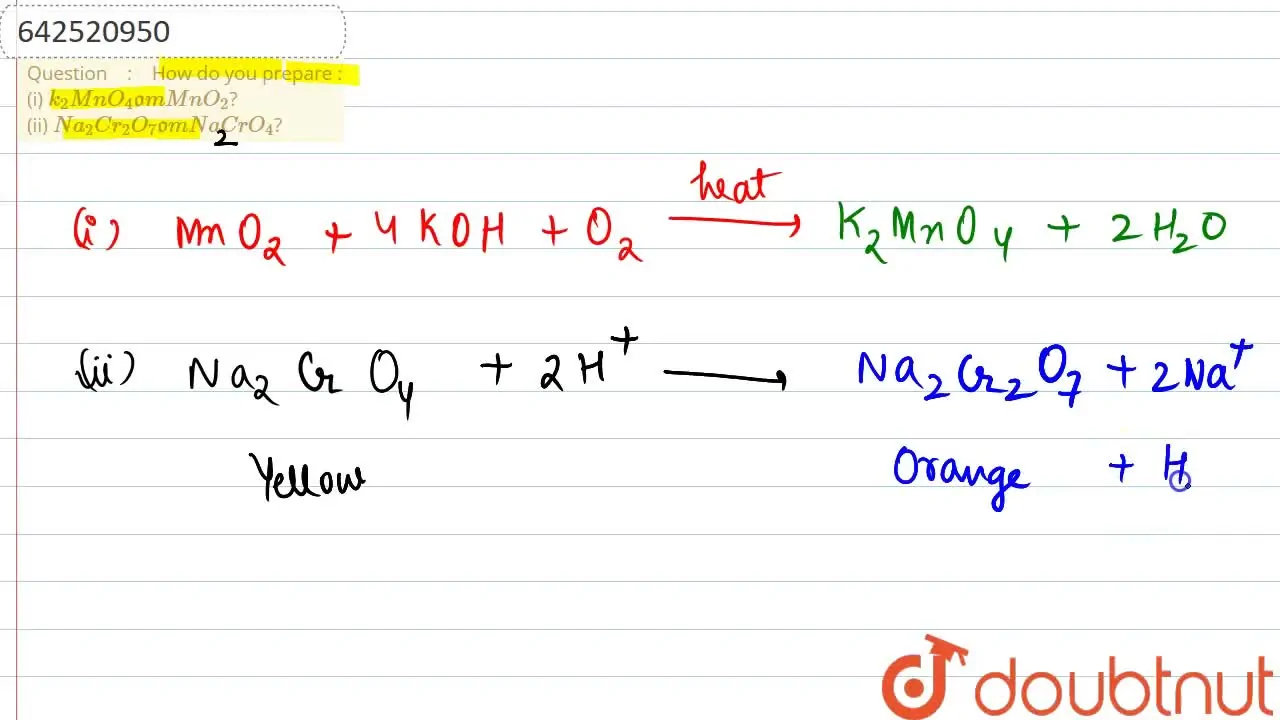How do you prepare :
(i) ?
(ii) ?
Video Solution
Text Solution
(i) can be prepared from pyrolusite . The ore is fused with KOH in the
prsence of either atmopheric oxygen or an oxidising agrant,such as
to given .
(ii) can be prepared from in the following way: For the preparation ltbtgt of solution dichromate is acidified with sulphuric acid to give a solution from which
orange sodium dichromate, can be crystallised .
Balanced equation for above reactions is as follows :
(b) (i) Electronic configuration of Electronic configuration of .
lt is known that half-filled and fully-filled orbitals are more stable . Therefore ,
Mn in state has a stable configuration. Therefore, shows resistance to oxidation of . Also, configuration and by losing one electron, its configuration changes to more stable configuration. Therefore, gets oxidised to easily.
The extent of metallic bonding an element undergoes, decides the enthalpy of
atomisation. The more extensive the metallic bonding of an element, the more will be
its enthalpy of atomisation. Zinc only form metallic bonding but no d-d overlapping
Whereas in other metals, both metallic as well as covalent bonding involve, enthalpy
of atomisation is lowest for zinc.
(iii) Actinides exhibit larger oxidation states because of very small energy gap between 5f, 6d and 7s sub-shells . The energies are calculated on the basis of (n + 1) rule. The (n+ 1) values of the three orbitals are :
5f = 5 + 3 = 8
6d = 6 + 2 = 8
7s = 7 + 0 = 7
Since, all the values are almost same, therefore all orbitals can involved in bonding
resulting in larger oxidation number for actionids.
|
Updated on:21/07/2023
Related Playlists
- BOOK - XII BOARD PREVIOUS YEAR PAPER ENGLISHCHAPTER - XII BOARDSEXERCISE - SET - II12videos
XII BOARDS
- BOOK - XII BOARD PREVIOUS YEAR PAPER ENGLISHCHAPTER - XII BOARDSEXERCISE - SET- III10videos
XII BOARDS
- BOOK - XII BOARD PREVIOUS YEAR PAPER ENGLISHCHAPTER - SAMPLE PAPER 2019EXERCISE - SECTION: D1videos
SAMPLE PAPER 2019
Similar Questions
K2Cr2O7+NaoH→CrO2−4
View SolutionK2Cr2O7+NaoH→CrO2−4
View SolutionWrite the preparation of following :
(i) KMnO4 from K2MnO4
(ii) Na2CrO4 from FeCr2O4
(iii) Cr2O2−7 from Cr2O2−4View SolutionNa2CrO4+HCl→H2Cr2O7+Na2SO4
View SolutionNa2CrO4+HCl→H2Cr2O7+Na2SO4
View SolutionK2MnO4+H+→KMnO4+MnO2⏐↓
View SolutionK2MnO4+H+→KMnO4+MnO2⏐↓
View SolutionOxidation number of Mn in K2MnO4 is
View SolutionConsider the following reactions :
(i) C2O2−4→CO2
(ii) SO2−4→SO2−3
(iii) MnO2−4→MnO−4
(iv) Fe3+→Fe2+
Choose the correct answer -View SolutionComplete the following reactions :
(a) Al(OH)−4+CO2→?+?+?
(b) Ag++Na2S2O3→?+?
(c) MnO−4+H2SΔ−−→?+?View Solution


